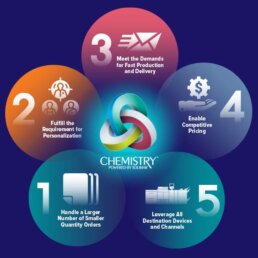5 Must-Read Reasons Augmented Reality Isn’t Hype—Especially for Print

This isn’t the first time you have likely heard of Augmented Reality (AR). It also probably isn’t the first time you have heard that AR will change the print game. So what is different at this point in 2020? Technology and a complete change to our perspective due to the COVID-19 pandemic. And even though there is sadness and loss associated with the pandemic, new technology opportunities are emerging in the AR landscape that will greatly help people and how they gain access to information.
Why isn’t this all hype…especially for the printers out in the world? Five reasons:
- AR can be leveraged with or without an app. (yes, you read that right, without an app)
- AR gives instant access to content from almost any print…including flyers, documents, statements, letters, labels, packages and posters.
- The AR content associated with a printed piece may be updated at any time.
- Content in the AR system may change based on a person’s location and personalized to them or their region.
- Drive ROI with AR usage—especially in conjunction with promotions like that from the USPS.
Let’s unpack this a little bit so you can see the significant opportunity for print and AR, as well as, why your print business should look to leverage it.
First, the big news you might not have been expecting is that you can now leverage AR without that pesky requirement of having an app. As we discussed with people, and our partners over at realityBLU, we found that the need for the app as part of the ability to roll out an AR experience was difficult to overcome. Many smaller companies don’t have apps. And for the larger brands that do, the people creating the print messaging—including statements, letters, flyers, promotional materials—often don’t have access to the app to embed an SDK (Software Development Kit). If they can use an SDK, it usually comes with a much longer approval, business case, and ROI (or Return on Investment). It is called WebAR, and it is available today.
Just as a quick detour, WebAR works by leveraging a camera-enabled mobile device, a QR code, and a mobile-based browser on the device. That not only reduces requirements, it also lets you expand to app-based experiences once you have ROI in your organization. That should be a win-win in any printer or brand’s book.
Reason two and three deal with the kind of printed material you can apply AR to, the content that can be delivered and the timely nature of that content. The first one is really easy; if you can put a QR code on it or a “marker” to trigger the image recognition, then you can place an AR experience on it.
That really makes it somewhat limitless. Common items include printed pages, packages, labels, direct to print packaging and garments, posters, billboards, and even grand format graphics like used at football fields and on buildings.
Now that you know you can put AR on nearly anything, what kind of content can you deliver? It is much more than bunny ears and funny faces that we see via Snapchat and other social media platforms. The content can be video, contact information, animated instructions, gamification, a portal to shopping and for your furniture lovers out there you are even able to place furniture right in your living room to see how it looks. We think you get the idea, but what is more, is that you are able to load up to 5 experiences from one QR code driving to WebAR. That makes it pretty rich with opportunity.
The fourth reason is just like the age-old saying, “Location, location, location.” In AR’s case, what we want you to remember is that you can use the location of where a user is accessing the AR experience to trigger the experience they have. A timely example is directing people to the nearest location for take-out or delivery for a restaurant client. You mail them a postcard on behalf of your restaurant client, it instructs them to scan the code for coupons and their nearest location and that is the experience that it delivers.
We can see the wheels turning for how you will be able to use the above example for disaster messaging, help and support, instructions, statements, letters, medical and pharmaceutical and much, much more. And, if your client knows their audience, this can be personalized with their first name or favorite order. Without data on the client, it could be personalized for the region or neighborhood because you or your client know specifics about the buying habits or needs in that area.
Finally, the ROI reason—the fifth and final must-read for AR in 2020. Especially in the U.S. right now, there is a postal discount for thoughtful AR usage on what the USPS specifies as “Regular and nonprofit Marketing Mail letters and flats, and First-Class Mail® presort or automation letters, cards, and flats.” Up to a 2% savings on the postage. We have seen $40,000 to well over six-figures in savings from this promotion in 2019 and mailers can take advantage of this in the U.S. until the 31st of August.
If you aren’t able to access mailing ROI in your country, then consider this: how much time could an organization save from calls with more information available? Or, what about the ability to shop or buy immediately because the information was so relevant. The reality of the AR experience we have seen is that they literally pay for themselves.
So, what are you waiting for? Discover how you can create a beneficial and profitable marriage between your print offerings and Augmented Reality. It works for all kinds of print, whether it is promotional, educational, information, tactical or wearable. Be the innovator and profit driver in your organization by bringing this forward-thinking technology in-house. Contact us to learn more today.
Author

Jonathan Malone-McGrew
Senior Director, Engagement – Solimar Systems
jmm@solimarsystems.com
linkedin.com/in/jemcgrew
About the Author
With family roots in the print and digital communications space, Jonathan brings an understanding of client and partner environments, technologies and the resulting challenges. Responsible for partner and client engagement, he is always willing to lend his expertise.
For more information, call the Solimar Sales Team at +1.619.849.2800.




